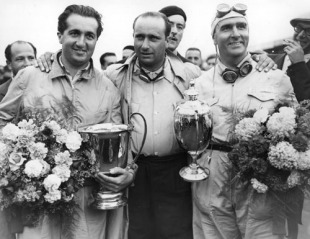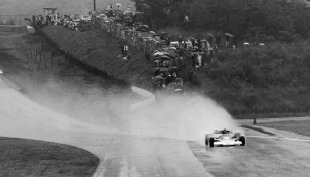|
Formula One (the formula in the name refers to a set of rules to which all participants and cars must comply and was originally and briefly known as Formula A) can trace its roots back to the earliest days of motor racing, and emerged from the buoyant European racing scene of the inter-war years. Plans for a Formula One drivers' championship were discussed in the late 1930s but were shelved with the onset of World War Two.  In 1946 the idea was rekindled and in that season the first races were held and the following year the decision was made to launch a drivers' championship. It took until 1950 for the details to be hammered out and in May 1950 the first world championship race was held at Silverstone - the first F1 race had taken place a month earlier in Pau. Only seven of the twenty or so Formula One races that season counted towards the title but the championship was up and running. Even as more races were included in the championship, there were plenty of non-championship Formula One races. Non-championship races continued until 1983 when rising costs ruled them unprofitable. There were no shortage of privateers - drivers who operated on their own and who bought and raced their own cars. Nevertheless, the formula was dominated by major pre-war manufactures such as Alfa Romeo, Ferrari, Maserati and Mercedes Benz. Although Giuseppe ("Nino") Farina won the inaugural title, the key driver in the 1950s was Juan Manuel Fangio who won the drivers' championship in 1951, 1954, 1955, 1956 and 1957 with five different manufacturers. It was not an easy beginning. In 1952 and 1953 the lack of entrants meant the authorities ran races to Formula Two regulations, with Alberto Ascari winning the championship in both years. Of the 20 makes that competed in 1950, most were soon forced out by the cost. Only Ferrari have competed since the off. The death toll in races was gruesome - 13 drivers were killed in F1 cars in the first decade. The cars made considerable technological advances. The first seasons were run using pre-war cars like Alfa's 158. They were front engined, with narrow-treaded tyres and 1.5 litre supercharged or 4.5 litre normally aspirated engines. When Formula One regulations returned in 1954 engines were limited to 2.5 litres. Mercedes Benz made major developments until they withdrew from all motor sports in the aftermath of the 1955 disaster at Le Mans. In the late 1950s Cooper introduced a rear-engined car and by 1961 all manufacturers were running them. As an added incentive for the teams, a constructors' championship was introduced in 1958. An era of British dominance was ushered in by Mike Hawthorn's championship win in 1958, although Stirling Moss had been at the forefront of the sport without ever securing the world title. Between Jim Clark, Jackie Stewart, John Surtees, Jack Brabham, Graham Hill, and Denny Hulme, British and Commonwealth drivers won nine drivers' championships and British teams won ten constructors' titles between 1962 and 1973. The iconic British Racing Green Lotus, with a revolutionary aluminum-sheet monocoque chassis instead of the traditional space-frame design, was the dominant car, and in 1968 the team broke new boundaries when they were the first to carry advertising on their cars. In 1970 Lotus' Jochen Rindt won the drivers' championship posthumously, the only man to do so, underlining the continuing risks. His replacement as Lotus' No. 1, was young Brazilian Emerson Fittipaldi, he then split the next four championships, with Jackie Stewart taking 1971 and 1973 for the new Team Tyrrell and Fittipaldi 1972 and 1974. The cars became faster and slicker - Lotus again were the innovators when they introduced ground-effect aerodynamics that provided enormous downforce and greatly increased cornering speeds - by the early 1970s the days of private entries were all but over as the costs of racing rocketed. Not only that, with the advent of turbocharged cars, speeds and power also raced ahead. Safety remained a concern - Stewart retired on the eve of what would have been his final race following the death of his close friend and team mate Francois Cevert in practice ahead of the 1973 US Grand Prix. In 1975 Fittipaldi refused to drive in the Spanish Grand Prix which was stopped after 29 laps when a car ploughed into the crowd, killing four spectators. Ferrari began to reassert themselves with drivers Niki Lauda and Clay Regazzoni, the former capturing the first of three drivers' titles in 1975. He won six of the first nine races in 1976 before a horrendous crash at the German Grand Prix left him with burns so severe he was not expected to live. Almost unbelievably he was back in the cockpit six weeks later and the championship went down to the wire, James Hunt edging out the courageous Lauda in the final race.  Lotus again led the way in 1978 with the introduction of ground-effects technology (using side skirts and underbody design to give the car phenomenal grip, albeit temperamentally) and Mario Andretti was supreme as he won six of the 16 races. But the year was again marred by a tragedy as team-mate Ronnie Peterson was killed at Monza. This marked the beginning of the end for the legendary Lotus team and was their last championship-winning year. In the early 1970s Bernie Ecclestone rearranged the management of Formula One's commercial rights, turning the sport into a billion-dollar global business. In 1971 he bought the Brabham team and so gained a seat on the Formula One Constructors' Association (FOCA) and in 1978 became its president. Until Ecclestone, circuit owners controlled many aspects of the sport; he persuaded the teams of their worth and the value of negotiating as a coordinated unit. In 1979 FISA (Fe'de'ration Internationale du Sport Automobile) was formed and almost immediately clashed with FOCA over revenues and regulations. Matters deteriorated to the extent FOCA boycotted a race and threatened a breakaway (tactics that were turned on Ecclestone years later). In return FISA removed its sanction from races. An uneasy truce came with the 1981 Concorde Agreement. In 1980 Alan Jones and the Williams team dominated and in 1981 Nelson Piquet took the title by one point with victory at the U.S Grand Prix. 1982 seemed set to be centered on a rift between Ferrari's Gilles Villeneuve and Didier Pironi but Villeneuve was killed at Zolder. Four weeks later, at the start of the Canadian Grand Prix, Pironi was so badly injured in a crash that claimed the life of Ricardo Paletti that he never raced again. From then on turbos, which first appeared in 1977, came to rule the roost. Piquet won his second title in 1983 with Brabham, and Lauda's half-point win in 1984 heralded the start of a period of dominance by McLaren in which they won the drivers' title in seven out of eight years with Alain Prost and Ayrton Senna. The team's zenith came in 1988 when they won 15 of the 16 races but for the following season turbos were banned, and the relationship between the two drivers deteriorated rapidly. To combat the phenomenal power of cars, restrictions were brought in and eventually turbochargers were banned altogether in 1989. In the 1980s electronic drivers aids began to emerge (again Lotus were at the forefront) and by the early 1990s semi-automatic gearboxes and traction control were a natural progression. The battle between new technology and the desire of the FIA to counter accusations that the drivers were increasingly less relevant than the boffins, raged throughout the next two decades. McLaren and Williams continued to rule the roost in the 1990s. In all, McLaren won 16 championships (seven constructors', nine drivers') in that period, while Williams matched them with 16 titles of their own (nine constructors', seven drivers'). But the rivalry between Prost and Senna ended in 1993 with Prost's retirement and then in 1994 Senna died at Imola. His death was a watershed, in that it led to considerable increases in safety standards - no driver has died at the wheel of an F1 car since then. The FIA introduced measures to slow the cars and improve their safety. But purists continued to argue the race was more about the technicians and designers than drivers, and like many other sports, a few teams dominated. McLaren, Williams, Renault (formerly Benetton) and Ferrari won every World Championship from 1984 until 2008. The soaring costs of Formula One widened the chasm between the big four and the smaller independents. Between 1990 and 2008 28 teams came and went, few making more than an ephemeral mark.  The most dominant figures during this time were Michael Schumacher and Ferrari, who won an unprecedented five consecutive drivers' championships and six consecutive constructors' championships between 1999 and 2004. Schumacher was a brilliant driver but his habit of pushing rules and sportsmanship to the limit made him a hard man to warm to, and that allied to his success further caused problems for the sport's popularity. Viewing figures dropped and concerns grew for the sport's future given the increasing difficulty for any new entrants to make an impression. Championship rules were frequently changed by the FIA with the intention of improving the on-track action and cutting costs. In 2002 team orders, legal since the championship started in 1950, were banned after several incidents in which teams openly manipulated race results, generating negative publicity, most famously by Ferrari at the 2002 Austrian Grand Prix. There was tinkering over points scoring, pit stops, engines and tyres. From 2000 manufacturer-owned teams returned with success - McLaren the exception - as Renault, BMW, Toyota, Honda and Ferrari dominated the championship, and through the Grand Prix Manufacturers Association (GPMA) they negotiated a larger share of Formula One's commercial profit and a greater say in the running of the sport. The global expansion of Formula One continued with new races in lucrative markets in the far and Middle East. Schumacher's retirement in 2006 coincided with the sport again becoming more competitive on the track, but increasingly the headlines were dominated by behind-the-scenes politics. Teams seemed to be on the verge of breaking away from F1 almost every year, scandal blighted officials and many believed Ecclestone and FIA chief Max Mosley had been around too long for the sport's good. The nadir came late in 2009 when it was revealed that Nelson Piquet Jnr had been ordered to crash at the 2008 Singapore Grand Prix for the benefit of his team-mate. Renault boss Flavio Briatore was subsequently banned, and even though that was overturned by a Paris court, it was yet another blow Formula One could have done without.
|
